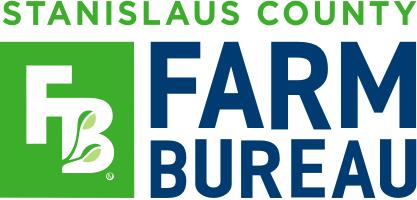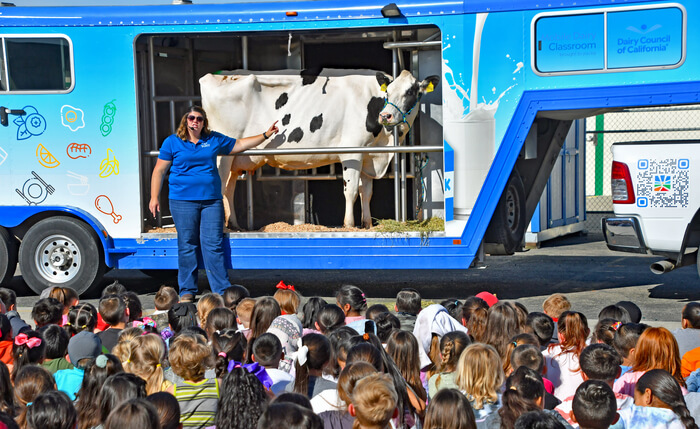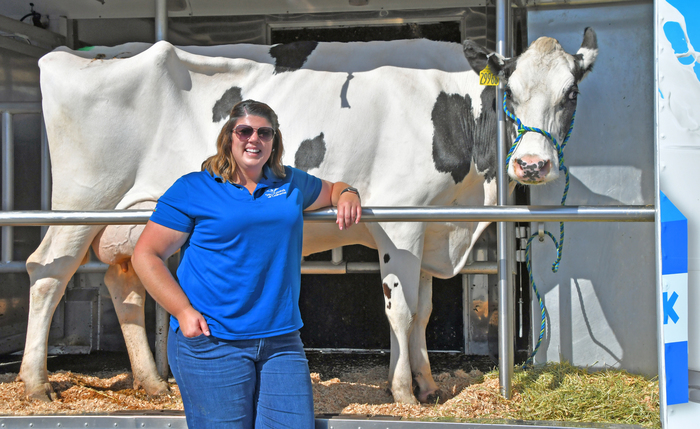By Vicky Boyd, Agriculture Reporter
Originally published in the Stanislaus Farm Bureau publication Stanislaus Farm News
 It was bring a cow to school day recently at Richard Moon Primary School in Waterford. The bovine show and tell was part of the Dairy
Council of California’s Mobile Dairy Classroom Program designed to educate elementary school students about where their milk and other food comes from.
It was bring a cow to school day recently at Richard Moon Primary School in Waterford. The bovine show and tell was part of the Dairy
Council of California’s Mobile Dairy Classroom Program designed to educate elementary school students about where their milk and other food comes from.
Holstein cow No. 229966, nicknamed Buttercup, and mobile dairy classroom instructor Miranda Blagg were the stars of the show, which had special meaning. Blagg attended Moon School from second through fourth grade, and she made the educational presentation in front of her mother, Jay Blagg, who is a preschool teacher.
“It’s a surreal feeling, and it’s a way I get to give back to my community,” Blagg said. “(Students) get to learn about agriculture and what’s going on around them. And it’s always fun to see teachers I had who are still here.”
Educating the public about where their food comes from is gaining importance as an increasing portion of the public has become further removed from agriculture, she said. Even in a town like Waterford, which is surrounded by farms, many people aren’t aware of the industry’s role in producing their food.
“This is a way to bridge that gap and give them their first look at ag,” Blagg said.
Nicole Morris — who with her husband, John, operate JNM Dairy southwest of Modesto — provides the loaner cows to Blagg for her educational efforts. As a dairy science professor at Modesto Junior College, Morris said she is a strong advocate for educating consumers about the importance of dairy and agriculture in general.
“If we’re to keep agriculture strong, we have to educate the next generation,” said Morris, who also posts as The Milk Diva (@ themilkdiva) on Instagram.
Denair dairy producer and Stanislaus County Farm Bureau First Vice President Vance Ahlem said the program is important because it not only educates the students, but also their parents and educators.
“The impact is well worth it for both the school to make the time investment and as an industry to continue the educational investments as well as to teach them about the dairy industry,” said Ahlem, who sits on the Dairy Council of California’s Board of Directors.
While the council obviously wants to talk about the benefits of consuming dairy products, he said the program has expanded to educate about all forms of better nutrition.
Moon School Principal Maria Tillery said programs such as the Dairy Council’s are important to help students learn more about their food and nutrition.
 “Kids are not always in the know of where milk comes from,” she said. “I think they have an idea, but they mostly
recognize it as coming from the store, from the gallon or the quart. (Milk) plays such a big part in the food chain, and it provides the yogurt and cheeses — all of the great food that we love.”
“Kids are not always in the know of where milk comes from,” she said. “I think they have an idea, but they mostly
recognize it as coming from the store, from the gallon or the quart. (Milk) plays such a big part in the food chain, and it provides the yogurt and cheeses — all of the great food that we love.”
These educational programs also foster closer connections to the “real world” that may someday inspire at least a few students to seek careers in agriculture or related fields, Tillery said.
Still important after all these years.
In existence since the 1930s, the Mobile Dairy Classroom Program was one of the first ag in the classroom programs in the state. It currently comprises six mobile dairy classroom instructors who focus on different parts of the state. The Dairy Council of California is funded through producer and milk processor assessments collected by the California Department of Food and Agriculture.
A four-year veteran of the Dairy Council, Blagg serves schools from Merced north to Yuba City and from Roseville west to Contra Costa County. She and her bovine partner are in high demand, and their schedule fills up quickly during the school year.
In fact, Ahlem said, the Mobile Dairy Classroom is the council’s most sought-after program. He credited the program’s long-term success to energetic staff members who really engage with their audiences.
Each year, the mobile effort reaches more than 400,000 students from pre-kindergarten through eighth grade, said Meggan Rush, Dairy Council communications program manager.
In addition, the council has instructional materials, curriculum packages and online options, such as videos, that teachers can use for classroom lessons. And all of it is free to educators, who are becoming more pushed for resources with budget constraints, she said.
“There are virtual field trips and online options basically available 24/7,” Rush said. “I really think that since we’ve been here for so long, it’s not just about dairy. It’s about ag education and nutrition — it’s all-encompassing.”
 For Blagg, the mobile dairy classroom program is a chance to combine her two passions — dairy and ag education. She didn’t grow up on a farm
but showed replacement heifers in 4-H and FFA. That’s where she fell in love with dairy cattle and the dairy industry.
For Blagg, the mobile dairy classroom program is a chance to combine her two passions — dairy and ag education. She didn’t grow up on a farm
but showed replacement heifers in 4-H and FFA. That’s where she fell in love with dairy cattle and the dairy industry.
While pursuing an animal science degree at California State University, Fresno, Blagg worked leading tours at Hilmar Cheese during summer breaks. It was there that she discovered her affinity for educating the public.
After graduation, Blagg eventually joined the Dairy Council, where she currently is one of six mobile dairy classroom instructors in the state. Blagg also is the California Farm Bureau State Young Farmers & Ranchers Committee representative for Stanislaus and Tuolumne counties.